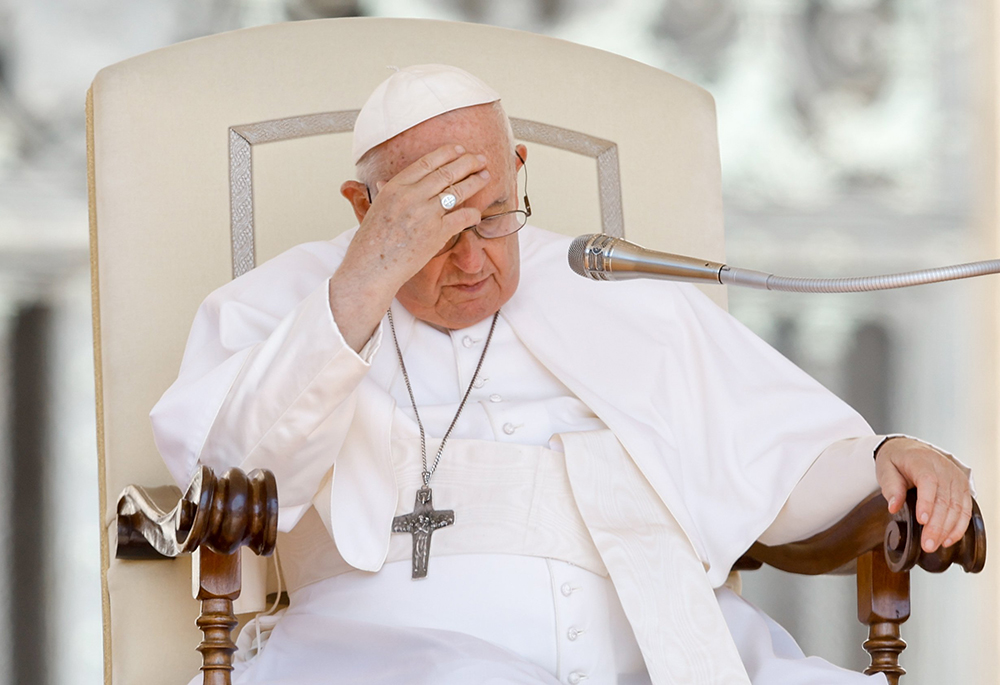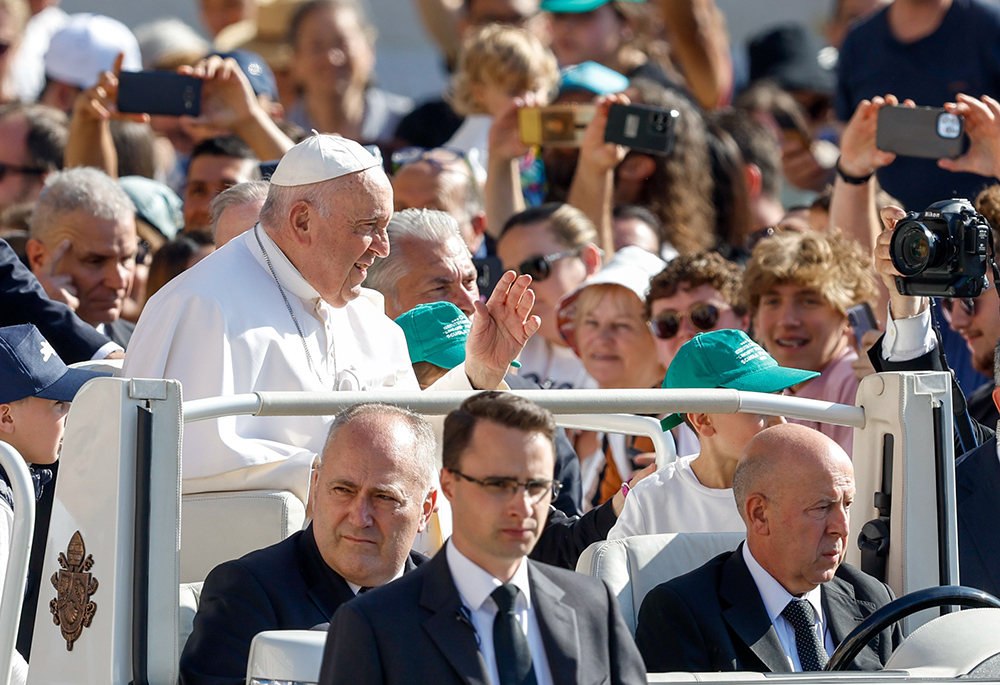
Pope Francis places his hand on his forehead during his weekly general audience in St. Peter's Square June 7 at the Vatican. (CNS/Lola Gomez)
It took 203 minutes between the time the Italian news agency ANSA first reported on June 6 that Pope Francis had been taken to a Roman hospital for tests and when the Vatican offered any sort of comment on the visit — much to the everlasting frustration of those of us who spend our days covering the institution and its leader.
The Holy See Press Office's performance improved the following day when there was only a 15-minute delay between the first reports that the 86-year-old Francis would return to Rome's Gemelli hospital on June 7 for an unannounced surgery on his intestine and the Vatican's official confirmation.
As we now await further specifics on the pope's operation and recovery, a few lessons have already emerged from the whole ordeal about both the Vatican's communications apparatus and Pope Francis himself.
First, it remains clear that the pope alone is primarily controlling both his own health care decisions and how reports surface about his condition. News of his June 7 surgery came within an hour after he finished his weekly general audience, where he remained silent about his pending operation during nearly two hours of speaking to pilgrims and greeting newlyweds and VIP guests in attendance.
There was a deja vu quality about the whole ordeal.

Pope Francis greets visitors from the popemobile as he rides around St. Peter's Square at the Vatican before his weekly general audience June 7. (CNS/Lola Gomez)
It was a Sunday afternoon on July 4, 2021, when Francis entered hospital for his first abdominal surgery that would keep him in the hospital for 11 days. Earlier in the day, Francis had carried on with his normal agenda by addressing pilgrims in St. Peter's Square during his scheduled Sunday Angelus, all the while staying mum on news of what at that point was the biggest health scare he had encountered as pope.
The octogenarian pope, who seldomly shies away from the spotlight and feeds off the public energy he receives, has consistently chosen to be his own messenger and to exercise discretion about what he reveals about his own health. Despite his own deeply prayerful nature, on neither occasion did he use these large gatherings of Catholics to ask for their prayers for what awaits him.
On June 6, when news first broke that the pope had been taken to the hospital, I was moderating a panel inside the Vatican when an Italian archbishop sitting on the dais next to me announced the news to the room after checking a message on his phone. I imagine that many of the attendees at the conference heard the news before most members of the press or the Vatican officials who serve the pope.
Advertisement
During the vexing interregnum between unofficial news reports and the Vatican actually commenting on them or the pope's condition, the Holy See Press Office did, however, send out a news bulletin announcing the full schedule of Francis' Aug. 2-6 trip to Portugal and opening up the process for journalists to apply to be on the papal flight.
Again, another parallel came to mind.
It was on that same Sunday on July 4, 2021, just hours before the pope underwent his operation, that Francis used his Sunday Angelus address to announce that he would travel to Hungary and Slovakia two months later in September 2021.
Traveling and getting out of the Vatican "keeps me active," the pope recently told reporters en route back from Budapest in April. Call it a diversion or a sort of papal insurance policy, but whatever it is, announcing trips seems to be an intentional, if understated, way to signal that this 10-year-old pontificate isn't over yet.
Before this latest papal health scare, there have been a series of articles and events here in Rome commemorating the long-delayed release of the memoir of Joaquín Navarro-Valls, the longtime spokesperson and confidant to Pope John Paul II.
Navarro-Valls was known for having unfettered access to the pope, which also provided him the ability to provide journalists with authoritative accounts of what the pope was actually thinking or planning. It's a stark contrast to today, when Francis' press officers are often the last to know or share information (largely owed to the fact that they're cut off from the top ranks of the Vatican's leadership, including the pope himself).
In February 2005, just months before the Polish pope died, Navarro-Valls — who was also known for his hyperbolic defenses of the pope at all costs — infamously and absurdly claimed that John Paul II had enjoyed 10 small cookies just hours after recovering from a tracheotomy at the same Roman hospital where Francis is now recovering.
In the Francis era, reporters have seldom had to endure that level of regular spin, though the Vatican press office did try to initially describe the pope's emergency April hospitalization as a previously scheduled visit.
And on Wednesday evening, after the pope's three-hour surgery, the Holy See Press Office organized a briefing with the chief medic who performed the operation, offering a marked improvement from his last one in July 2021 when scant medical details were provided.
As we await further news on the pope's recovery, this change in strategy is welcome news, but also a reminder that there remains a need for continued healing — both for the pope and for Vatican communications.




